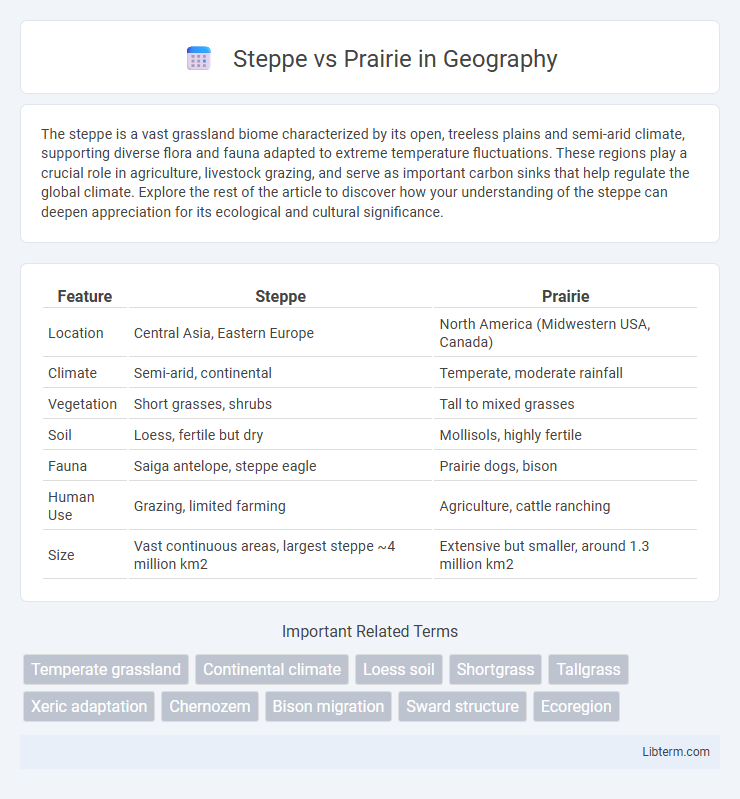The steppe is a vast grassland biome characterized by its open, treeless plains and semi-arid climate, supporting diverse flora and fauna adapted to extreme temperature fluctuations. These regions play a crucial role in agriculture, livestock grazing, and serve as important carbon sinks that help regulate the global climate. Explore the rest of the article to discover how your understanding of the steppe can deepen appreciation for its ecological and cultural significance.
Table of Comparison
| Feature | Steppe | Prairie |
|---|---|---|
| Location | Central Asia, Eastern Europe | North America (Midwestern USA, Canada) |
| Climate | Semi-arid, continental | Temperate, moderate rainfall |
| Vegetation | Short grasses, shrubs | Tall to mixed grasses |
| Soil | Loess, fertile but dry | Mollisols, highly fertile |
| Fauna | Saiga antelope, steppe eagle | Prairie dogs, bison |
| Human Use | Grazing, limited farming | Agriculture, cattle ranching |
| Size | Vast continuous areas, largest steppe ~4 million km2 | Extensive but smaller, around 1.3 million km2 |
Introduction to Steppe and Prairie
Steppe refers to vast, treeless plains primarily found in Eurasia, characterized by semi-arid climates and sparse vegetation dominated by grasses and shrubs. Prairie describes extensive grasslands in North America, featuring fertile soil and a wetter climate that supports tall grasses and diverse plant species. Both biomes serve as crucial habitats for migratory animals and play significant roles in global carbon cycles and agriculture.
Defining Steppe: Key Characteristics
Steppe landscapes are vast, flat, and treeless regions dominated by grasslands, primarily found in Eurasia, especially Central Asia and parts of Eastern Europe. These ecosystems experience extreme temperature variations, with hot summers and harsh winters, and receive low annual precipitation typically between 250 to 500 millimeters. The soil in steppes is often fertile and rich in organic matter, supporting grasses and herbaceous plants adapted to drought and grazing pressures.
Understanding Prairie: Main Features
Prairies are extensive, flat or gently rolling landscapes dominated by perennial grasses, wildflowers, and few trees, primarily found in North America. Their rich, deep topsoil supports a diverse ecosystem of flora and fauna adapted to periodic droughts and fires. Prairies play a crucial role in carbon sequestration and serve as important grazing grounds for livestock and wildlife.
Geographic Distribution of Steppe and Prairie
The steppe primarily spans Central Asia, covering vast areas in countries such as Kazakhstan, Russia, and Mongolia, characterized by its semi-arid climate and grassland vegetation. In contrast, the prairie is predominantly found in North America, especially in the United States and Canada, featuring fertile soil and moderate rainfall that supports tallgrass ecosystems. These geographic distinctions influence the biodiversity and land use practices unique to steppe and prairie regions.
Climate Differences: Steppe vs Prairie
Steppes experience a semi-arid climate with low precipitation, typically ranging from 250 to 500 mm annually, leading to dry conditions and sparse vegetation. Prairies have a more humid climate with annual rainfall between 500 and 1,000 mm, supporting dense grasslands and rich biodiversity. Temperature variation is more extreme in steppes, with hot summers and cold winters, whereas prairies often have milder seasonal changes due to higher moisture levels.
Soil Composition and Fertility
Steppe soils, primarily chernozem, contain high organic matter and nutrients, supporting moderate to high fertility ideal for cereal crops and grasses. Prairie soils also feature rich chernozem but often exhibit higher moisture retention and organic content, leading to superior fertility for diverse agriculture including corn and wheat. Both soil types are prized for agricultural productivity, but prairies generally offer more consistent moisture and nutrient availability.
Plant Diversity and Vegetation Types
Steppes are dominated by drought-resistant grasses and sparse shrubs adapted to semi-arid climates, supporting lower plant diversity compared to prairies. Prairies feature tallgrass, mixed-grass, and shortgrass vegetation, fostering higher biodiversity with a variety of grasses, wildflowers, and herbaceous plants. The denser soil moisture and more frequent rainfall in prairies promote richer plant communities than the predominantly xerophytic species found in steppes.
Common Wildlife and Animal Adaptations
Steppes host species such as saiga antelope, marmots, and steppe eagles, while prairies support bison, prairie dogs, and coyotes, reflecting distinct fauna adapted to their environments. Steppe animals are adapted to extreme temperature fluctuations and sparse vegetation, with behaviors like burrowing and seasonal migration to conserve energy and evade predators. Prairie wildlife often exhibits adaptations for grassland navigation and grazing, including specialized teeth for tough grasses and social structures enhancing survival in open habitats.
Human Impact and Land Use
Steppe regions, primarily found in Central Asia, have experienced significant human impact due to extensive livestock grazing and agricultural expansion, leading to soil degradation and loss of native vegetation. Prairie ecosystems in North America have been largely converted to farmland for crops such as wheat and corn, resulting in habitat fragmentation and reduced biodiversity. Both landscapes face challenges from overgrazing, urban development, and resource extraction, which alter their natural ecological functions and threaten long-term sustainability.
Conservation Challenges and Future Outlook
Steppe and prairie ecosystems face significant conservation challenges due to habitat fragmentation, invasive species, and climate change effects, threatening native biodiversity and ecosystem services. Effective management requires large-scale restoration efforts, protection of keystone species, and integration of sustainable land-use practices to maintain ecological resilience. Ongoing research and collaboration among governments, scientists, and local communities will determine the future outlook for these vital grasslands, emphasizing adaptive strategies to mitigate environmental pressures.
Steppe Infographic

 libterm.com
libterm.com